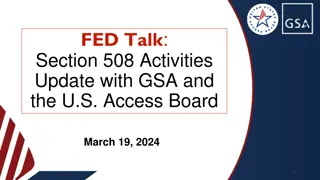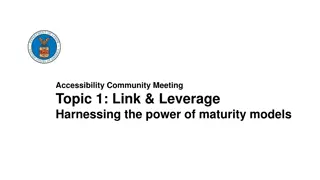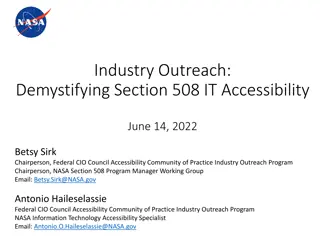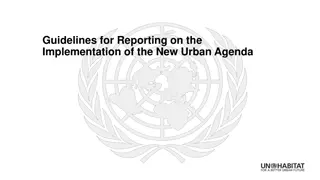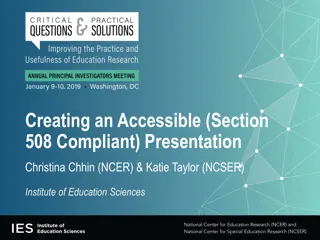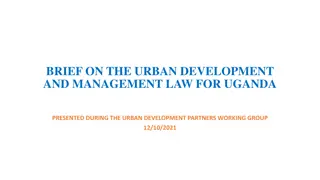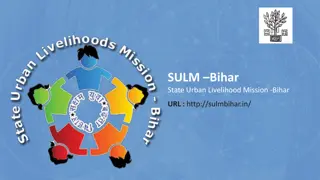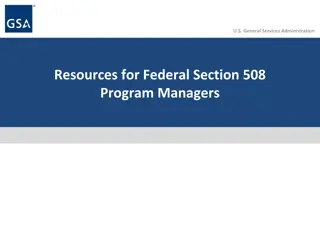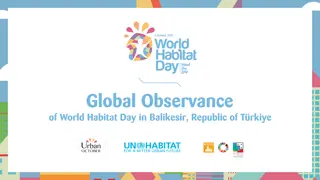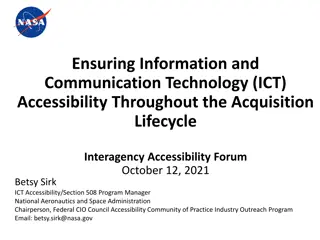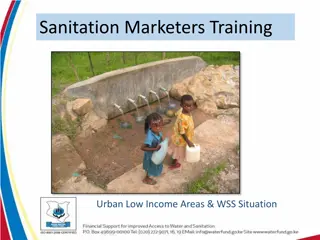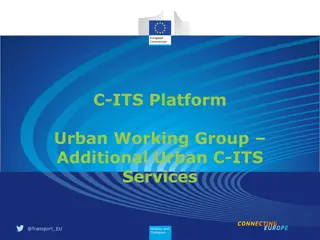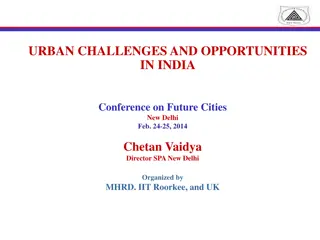Integrating Section 508 into the Development Life Cycle by Mark D. Urban
Mark D. Urban, CDC Section 508 Coordinator, discusses the importance of integrating Section 508 into the development life cycle. The presentation covers topics such as the basics of a life cycle, classic vs. modern development methods, authoring tools, validation, and the unique considerations for mobile development. It emphasizes the significance of understanding and incorporating Section 508 requirements from the early stages of development to ensure accessibility for all users.
Download Presentation

Please find below an Image/Link to download the presentation.
The content on the website is provided AS IS for your information and personal use only. It may not be sold, licensed, or shared on other websites without obtaining consent from the author.If you encounter any issues during the download, it is possible that the publisher has removed the file from their server.
You are allowed to download the files provided on this website for personal or commercial use, subject to the condition that they are used lawfully. All files are the property of their respective owners.
The content on the website is provided AS IS for your information and personal use only. It may not be sold, licensed, or shared on other websites without obtaining consent from the author.
E N D
Presentation Transcript
1 Integrating Section 508 into the Development LifeCycle MARK D. URBAN CDC SECTION 508 COORDINATOR FKA2@CDC.GOV
Introductions 2 Who am I? Mark Urban, HHS Co-Chair, CDC & ATSDR Section 508 Coordinator. Why are you here? Open, honest discussion on how to inject 508 into modern development
What You Will Learn 3 What s a Life Cycle , anyway? Classic vs. Latest Development Methods Why Authoring Tools Matter Validation Why Mobile is different
Whats a lifecycle? 4 Simply Put, it is: A way of describing growth and development. It can happen in a very formal process, or it can happen more organically It happens whether you put a name to it or not It will happen with or without you. But it happens better with you!
Making the call 6 Recommend No issues OR Issues have been remediated OR Issues cannot be fixed and that s OK (exception, remediation plan) Recommend with Conditions Issues, but the Project is working on it. Should be phrased as X will be done by DATE . Not Recommended Presents a clear and significant risk to the agency and the project is not working on the issues.
Classic Development LifeCycle Waterfall 7 Recognize need Define the problem Design a solution to the problem Analyze and validate the design Built to specific design Test to specifications Deploy system Bugfix & maintenance Retire system
Modern Development LifeCycle Iterative 8 Identify the overarching requirements and basic need. Develop: Define a part of the problem Build a solution to that part of the problem Does it solve that part of the problem? No go back and rebuild. Yes deploy that, then define another part and build that out. Repeat until as much of the problem is solved as resources allow. Bugfix & maintenance Retire system
Modern Development Types 9 Agile: emphasis on the business needs and constant realignment. Scrum: build fast, fail fast : development in very short sprints , with multiple releases. Lean Agile: hybrid of iterative development after more classic requirements gathering Developers must validate accessibility during each interation! DevOps: Emphasis on embedded dev teams who building just the pieces needed. I call this the Lego approach. User Interface components must be validated when built!
Modern 508 10 Ensure the Project Team have WCAG checklists in hand Evaluate the Sprint/Iteration plan for dealing with 508. You re looking for: 508 checks within the dev cycle, not just a 508 test at the end Adherence to standards (e.g. WCAG 2.0, HTML5) 508 SME/partners to do end-of-sprint validation. For large projects, You ll end up needing to create validation Check Points after a number of sprints to ensure it s still accessible
Why Authoring Tools Matter 11 With rapid development occurring by multiple developers, the 508 SME can t be everywhere. Code management, accountability, and QA are essential to accessibility. Development Environments are necessary, not just fancy text editors! Some COTS platforms are not accessible, and the devs will not be able to make them so. 508 should evaluate the tools/platforms being used to build the system BEFORE development starts. O and it s the law. [new 508 standards]
Validation of 508 Conformance 12 Overriding principle: you write it, you write it accessibly! With the move away from detailed design, developers are responsible for validating accessibility in every line of code they write. First Validation: Is it Valid Code? To test: depends on the authoring tool. Most mature IDEs have plugins that can help.
Validation of 508 Conformance 13 Second Validation: Is the output accessible? Automated tools can help here to find and manage issues Third Validation: Manual testing Keyboard navigation, color contrast, and focus trap testing. Assistive Technology validation by a trained tester. For enterprise projects: An additional test Sprint to do formal testing before a major release.
Why Mobile is Different 14 Mobile app projects often happen informally. Find out who owns the keys to your agency s account on Google Play and the Apple Store! Since they are not being deployed on the network, there is often no formal reviews or engagement. If no policy/process exists for mobile app clearance, its time to begin one, including 508 clearance. There are three types of mobile apps: Web apps: repackage the website info. Hybrid Apps: native apps that serve up HTML5 content and interaction True Native: apps that allow login and secure data.
Mobile App Considerations 15 The Authoring tool matters! For Web and Hybrid, code HTML5 to WCAG standards. For Hybrid and True Native: Code to device standards (Android or IOS, as appropriate). Acceptance Testing has to be done on an actual device.
16 Integrating Section 508 into the Development LifeCycle MARK D. URBAN CDC SECTION 508 COORDINATOR FKA2@CDC.GOV


